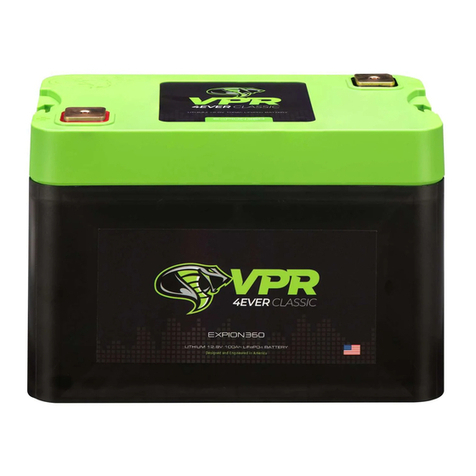9
Expion360 Battery Manual, G24 and G27
Rev 1
03/10/2022
2Battery Management System (BMS)
See the Battery Specifications page for complete BMS protection settings.
Short Circuit Protection:
If a short circuit occurs, the BMS will disconnect to protect the battery. When the short circuit condition is corrected, the
BMS will automatically reconnect. If the BMS does not reconnect, a charge is required to reset the BMS.
Overvoltage Protection:
If the charge voltage is higher than 14.6 Vdc ± 0.1 Vdc, the BMS will disconnect to protect the battery. When the
battery voltage falls to 14.2 Vdc ± 0.2 Vdc, the BMS will automatically reconnect. If the BMS does not reconnect, a
charge is required to reset the BMS. In some cases, it may take some time for the battery voltage to drop to 14.2 Vdc.
Undervoltage Protection:
If the battery reaches the minimum voltage of 9.5 Vdc ± 0.5 Vdc, the BMS will disconnect to protect the battery. A charge
is required within one week to prevent permanent damage and voiding the warranty of your battery. When the battery voltage
rises above 10.8 Vdc ± 0.4 Vdc, the BMS will reconnect. Some chargers will not charge if an open circuit is detected as
the BMS has disconnected. We recommend using our DC-DC charger or AC-DC charger to avoid this open circuit problem
and an Expion360 Battery Monitor to display voltage clearly.
Overcurrent Protection:
The BMS will monitor charge and discharge currents to protect the battery. If the charge or discharge current is too high,
the BMS will disconnect to protect the battery. When a high current condition is corrected, the BMS will automatically
reconnect. If the BMS does not reconnect, a charge is required to reset the BMS. See the specifications page for more
details.
Thermal Protection:
If the temperature is too high or low while charging or discharging the battery, the BMS will disconnect to protect the
battery. When the temperature is within the acceptable range, the BMS will automatically reconnect.
Cell Balancing:
The BMS will monitor and prevent each of the four cell bricks from overcharging. If the individual cell brick voltages are
outside the acceptable range, the BMS will automatically balance the cell bricks to bring them within range.





























